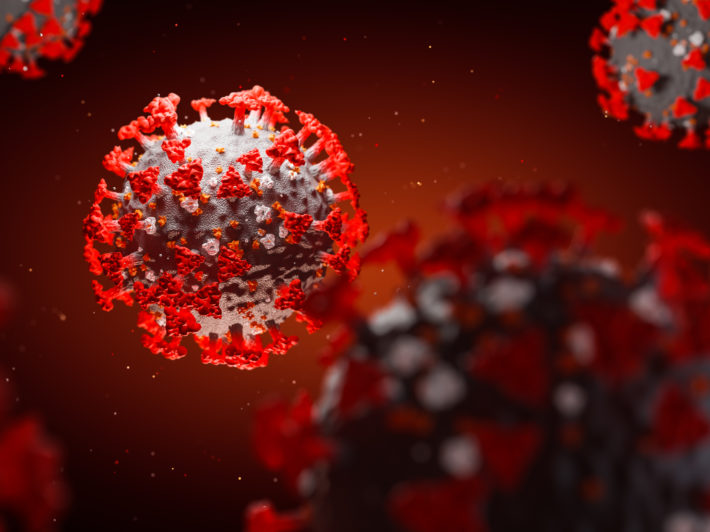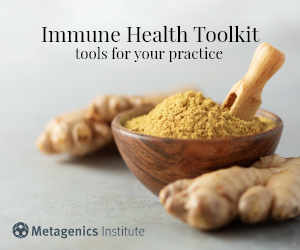
by Kara Fitzgerald, ND
It looks like pyroptosis, a novel form of inflammatory cell death, may be a cause of the increased virulence of COVID-19 (although it was seen in SARS-CoV-1, too). Pyroptosis initiates the upregulation of inflammasome NLRP31 via caspase-1 proteases in the canonical pathway. Other caspases can also upregulate the inflammasome initiated by a variety of triggers. The end results of NLRP3 upregulation include IL-1β and IL-18 production and cell death. In COVID-19 patients, higher serum IL-1β (a surrogate marker for NLRP3 activation) has been noted. And lymphocytopenia in COVID-19 is speculated to be due to chronic pyroptosis activation. On autopsy in four patients who died from SARS-CoV-1,2 it looks like pyroptosis-induced damage was present in multiple tissues including lungs, leading to significant organ damage. It’s thought that in SARS-CoV-1, the 3a protein2 activated the inflammasome in LPS-primed macrophages.
Of course, pyroptosis can be a protective antimicrobial response (damaged, infected cells are aggressively killed, and Th1 gets turned on via the cytokines initiated by NLRP3), but it can be chronically, inappropriately activated when hijacked by the virus. In fact, observed in some viral infections is an inhibition of cell death (normally triggered by gasdermin D, GSDMD), allowing inflammation and viral propagation to continue unabated.
Not surprisingly, chronic activation of pyroptosis3 can occur with other DAMP/PAMP4 exposures. Think proinflammatory/high-sugar and -processed food diets, dysbiosis/LPS, stress, toxins, drugs, ROS, mitochondrial damage, etc. Chronic activation has been noted in inflammatory diseases such as type II diabetes, obesity, autoimmune disease, cardiovascular disease, and cancer. Interestingly, it might be that CD4 T-cell5 depletion in HIV is mediated by caspase-1 pyroptosis.
The cytokine storm seen in SARS CoV-1 and CoV-2 might be due to chronic pyroptosis activation. However, known activators of NLRP3 in SARS-CoV differ from CoV-2.6 While SARS CoV-1 and COVID-19 are genetically very similar, the extraordinarily high rate of infectivity of COVID-19 is unique. Prepublication research7 suggests the cause might be a unique furin-like cleavage site on the spike protein of CoV-2 that was absent in CoV-1.
Understanding that treatments for COVID-19 are speculative, here are some considerations based on what we’re learning about pathophysiology.
1. Essential, powerful basics for all of us
In Functional Medicine (FxMed), we talk about the “MLF” or modifiable lifestyle factors. We want to get on that now (and for future prep): Resolve the baseline inflammation that could cumulatively add to COVID-19-driven inflammation.
- Clean, anti-inflammatory diet (see below; consider a keto-leaning diet or caloric restriction as a ramped up anti-inflammatory approach)
- Tend to gut as needed (gut permeability, LPS-driven endotoxemia, dysbiosis, inflammation, etc.)
- Reduce toxin exposures
- Sufficient nutrients
- Adequate sleep
- Exercise
- De-stress
- Connect with your fellow humans
2. A few considerations for taming inflammasome activation
- Melatonin
- Consider 3mg-30mg (the latter is used in oncology)
- Effective inhibitor of NLRP3 activation via a variety of mechanisms8
- The chief ketone β -hydroxybutyrate9 has been shown to inhibit inflammasome activation
- Consider caloric restriction
- Consider low-carbohydrate diet
- Consider MCT oil
- Exercise will fuel ketone production too
- Specialized pro-resolving lipid mediators
- SPMs inhibit priming and activation of macrophage NLRP3 inflammasome (in vivo, in vitro) Details: SPMs, specifically D210, suppressed IL-1 β production and secretion in LPS- and ATP-challenged macrophages. D2 was also shown to reduce inflammasome assembly and caspase-1 activity (cell studies). In vivo, D2 blocked the inflammasome as shown by reduced IL-1β release and increase M2 markers of inflammation resolution.
- There are a host of studies on SPMs and inflammation11, including inhibition of the inflammasome. While we need more human in vivo data, the research to date is very interesting. Note that we can make SPMs from omega-3 and arachidonic acid, but not everyone makes SPMs equally well (it’s thought that the failure of inflammation resolution, i.e., chronic inflammation, is the inability to kick in SPM production). Low-dose aspirin can support aspirin-triggered synthesis of some SPMs, whereas a full ASA dose and other NSAIDs can inhibit production.
- Palmitoylethanolamide (PEA)12
- Take 600 mg/day as prevention; 600 mg TID during active infection
- Shown to inhibit inflammasome
Furin-like cleavage site. Can we slow infectivity down?
Luteolin has been studied for its inhibition of pro protein convertase furin.13 Dengue fever, which also infects human cells via the furin cleavage system, was inhibited in vitro and in vivo by the application of luteolin; it appears that luteolin interrupted an efficient cleavage process rather than through competitive inhibition. Chinese herb Viola Yedoensis Makino, containing luteolin as a principle constituent, is widely used by TCM practitioners for dengue fever.
In vitro assays also show oroxylin A, chrysin, and baicalin are able to inhibit furin14, with oroxylin A being the most potent of the three. Oroxylin A and chrysin used in this study were isolated from the stem bark of oroxylum indicum.
Citations
- Yang Y et al. The deadly coronaviruses: The 2003 SARS pandemic and the 2020 novel coronavirus epidemic in China. J Autoimmun. March 3, 2020. [Epub ahead of print]
- He L et al. Expression of elevated levels of pro-inflammatory cytokines in SARS-CoV-infected ACE2+ cells in SARS patients: relation to the acute lung injury and pathogenesis of SARS. J Pathol. 2006;210(3):288-297.
- Bergsbaken T et al. Pyroptosis: host cell death and inflammation. Nat Rev Microbiol. 2009;7(2):99-109.
- Wang Y et al. Induction of pyroptosis and its implications in cancer management. Front Oncol. 2019.
- Doitsh G et al. Pyroptosis drives CD4 T-cell depletion in HIV-1 infection. Nature. 2014;505(7484):509-514.
- Fung S et al. A tug-of-war between severe acute respiratory syndrome coronavirus 2 and host antiviral defence: lessons from other pathogenic viruses. Emerg Microbes Infect. 2020;9(1):558-570.
- Coutard B et al. The spike glycoprotein of the new coronavirus 2019-nCoV contains a furin-like cleavage site absent in CoV of the same clade. Antiviral Research. 2020;176:104742.
- Favero G et al. Melatonin as an anti-inflammatory agent modulating inflammasome activation. Int J Endocrinol. 2017;2017:1835195.
- Youm YH et al. The ketone metabolite β-hydroxybutyrate blocks NLRP3 inflammasome-mediated inflammatory disease. Nat Med. 2015;21(3):263-269.
- Lopategi A et al. Frontline science: Specialized proresolving lipid mediators inhibit the priming and activation of the macrophage NLRP3 inflammasome. J Leukoc Biol. 2019;105(1):25-36.
- Serhan CN et al. Resolvins in inflammation: emergence of the pro-resolving superfamily of mediators. J Clin Investigation. 2018;128(7):2657-2669.
- Keppel Hesselink JM et al. Palmitoylethanolamide: A natural body-own anti-inflammatory agent, effective and safe against influenza and common cold. Int J Inflam. 2013;2013:151028.
- Peng M et al. Luteolin restricts dengue virus replication through inhibition of the proprotein convertase furin. Antiviral Research. 2017;143:176-185.
- Majumdar S et al. Proprotein convertase inhibitory activities of flavonoids isolated from oroxylum indicum. Curr Med Chem. 2010;17(19):2049-2058.
Kara Fitzgerald, ND, IFMCP received her doctor of naturopathic medicine degree from the National University of Natural Medicine in Portland, Oregon. She completed the first Counsel on Naturopathic Medicine-accredited postdoctorate position in nutritional biochemistry and laboratory science at Metametrix Clinical Laboratory (now Genova Diagnostics) under the direction of Richard Lord, PhD. Her residency was completed at Progressive Medical Center, a large, integrative medical practice in Atlanta, Georgia.
Dr. Fitzgerald is the lead author and editor of Case Studies in Integrative and Functional Medicine and is a contributing author to Laboratory Evaluations for Integrative and Functional Medicine and the Institute for Functional Medicine (IFM)’s Textbook for Functional Medicine. Most recently, with Romilly Hodges, she authored the eBook The Methylation Diet and Lifestyle. Dr. Fitzgerald has published numerous articles in peer-reviewed journals. Dr. Fitzgerald is on the faculty at IFM, is an IFM Certified Practitioner, and lectures globally on Functional Medicine. She is a clinician researcher for The Institute for Therapeutic Discovery. Dr. Fitzgerald runs a Clinical Development Program for professionals and maintains an active blog and podcast series on her website, www.drkarafitzgerald.com. Her clinical practice is in Sandy Hook, Connecticut.





